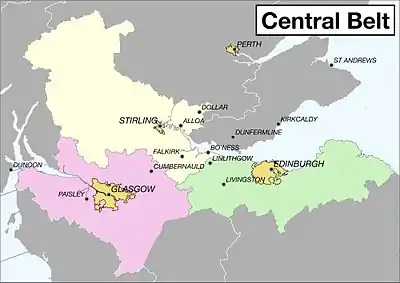The Central Belt of Scotland is that part of the country which stretches from Glasgow in the west to Edinburgh in the east, and contains the majority of the population. The region varies greatly, from the country's two major cities and the ancient capital, Dunfermline, to the rural areas of the South Region.
Regions


| Clydeside the area around Glasgow |
| The Lothians the area around Edinburgh |
| Stirlingshire and Clackmannanshire the mountainous, more rural counties in the north of the region |
Cities and towns
Cities
Towns
- 🌍 Bo'ness (Gaelic: Ceann Fhàil)
- 🌍 Motherwell (Gaelic:Tobar na Màthar ) administrative capital of North Lanarkshire, location of Strathclyde park
- 🌍 Falkirk (Gaelic: An Eaglais Bhreac)
- 🌍 Linlithgow (Gaelic: Gleann Iucha)
- 🌍 Livingston (Gaelic: Baile Dhùn Lèibhe)
- 🌍 Paisley (Gaelic: Pàislig) – a town known for its textiles, the popular raindrop pattern is also named after this town.
Other destinations
Understand
The Scottish Central belt is where the vast majority of the population live in the 40 miles or so between the two major cities, Glasgow and Edinburgh.
There are many connections between both cities that will travel through this narrow “waist” of Scotland: four rail routes, one main motorway (M8) although one can alternatively travel across the Forth Bridge (M9) and down the M90 to take in views across the Forth and skirting the beginnings of the Highlands just further north.
If you’re perceptive, you’ll notice an almost imperceptible difference in culture as you drift across the central belt that’s nonetheless obvious to most Scots.
Edinburgh is nicknamed “Auld Reekie”, after the smell that used to emanate from the mills and factories. People from the capital refer to Glaswegians as “Weegies”; although Glaswegians are often ignorant of this animosity, they return the favour with an idiom of their own about Edinburgh hospitality: “In Glasgow we say [to house guests] 'ye’ll be wantin' yer tea!', but in Edinburgh they’ll say ‘ye’ll have had yer tea!'"
There are many treasures around this part of the Lowlands, some of which are well off the beaten track: stop at the Wallace Monument, or visit Sumerlee Heritage Park in Coatbridge. Strathclyde or Callander Park is an easy visit to break up the bustle of city centres, while most towns here have a plethora of good golf clubs despite relatively urban surroundings.
In the Central Belt, you’ll see how most Scots live and learn a lot about the history of the country.
Get in
By car
Major roads into the Central Belt are:
- M74 bringing traffic from the north-west of England and south-west of Scotland to Glasgow
- A77 bringing traffic from the south-west of Scotland to Glasgow, via Ayr
- A1 bringing traffic from the north-east of England and south-east of Scotland to Edinburgh, via Berwick-upon-Tweed and Dunbar
- A7 & A68 bringing traffic from the Scottish Borders to Edinburgh
- A9 bringing traffic from the north of Scotland to Stirling, via Inverness and Perth
- A90 bringing traffic from Aberdeen and the north-east of Scotland to Edinburgh, via Dundee and Perth
By train
Trains from England arrive in the main rail stations in Glasgow and Edinburgh.
By plane
There are three major airports in this area of Scotland: one serving the capital, Edinburgh, and two serving Glasgow.
Get around
See Scotland#Get around.
- ScotRail run the rail franchise in Scotland. A few cross border trains are run by other companies, but they operate long distance services and only stop in the larger rail stations.
See
- Edinburgh Castle in Edinburgh
- The Burrell Collection in Glasgow
- The Wallace Monument in Bridge of Allan
Do
Eat
Drink
Sleep
Go next
- North to Scottish Highlands and North East Scotland
- South to South West and Scottish Borders